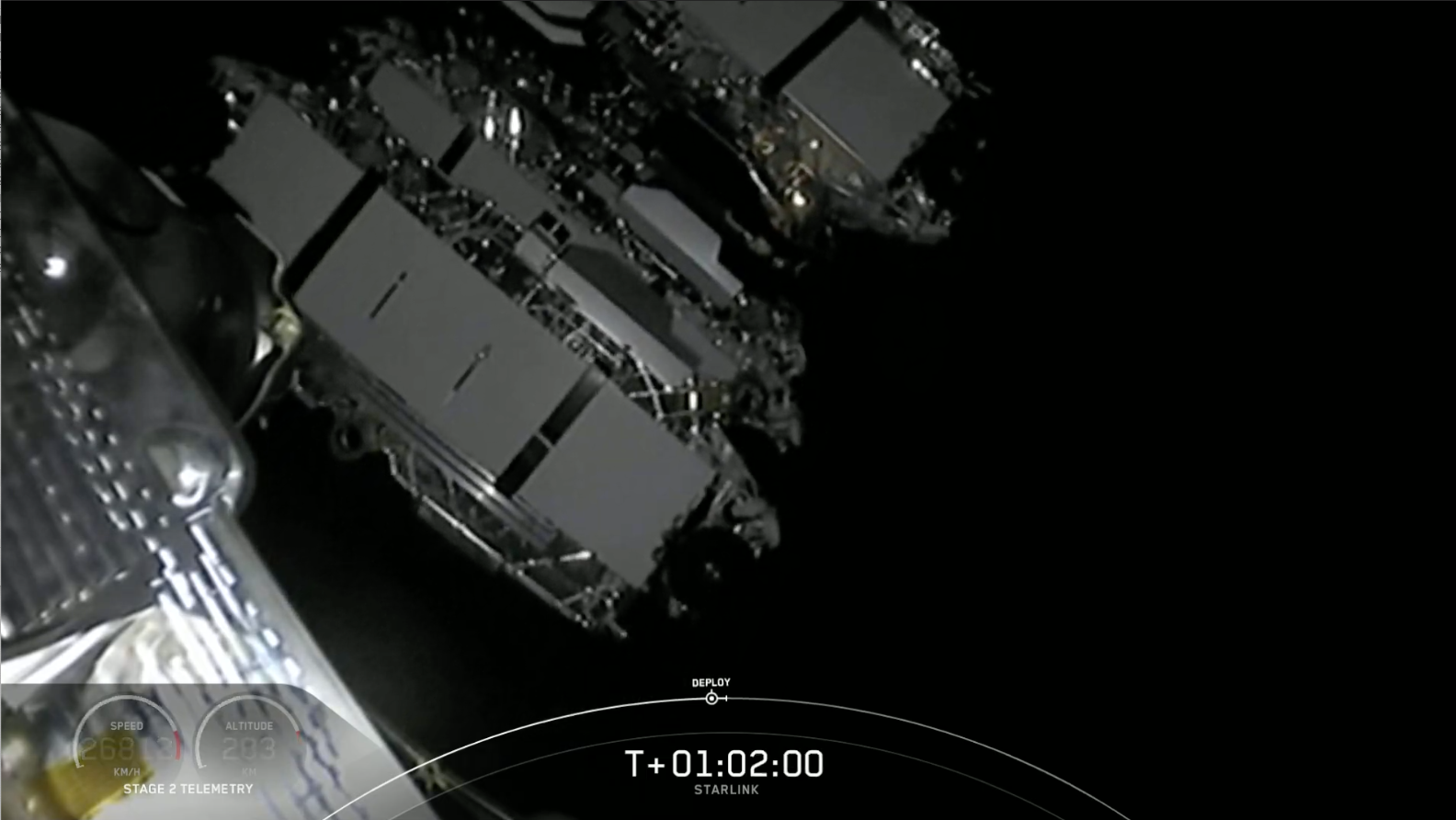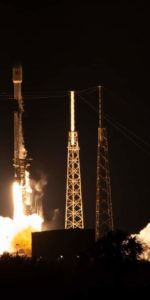
UPDATE – SpaceX has pushed one of their Starlink launches to Friday at 5:14am EST. Both missions were scheduled to launch four hours apart on Thursday. Original story is below:
It promises to be a very quick dash for AmericaSpace’s photographers between launch pads on Thursday morning, as SpaceX aims to fly not one, but two, Falcon 9 boosters from the Space Coast within a span of a little more than four hours of each other.
Liftoff of the five-times-flown B1059 core is targeted for 1:19 a.m. EST from Space Launch Complex (SLC)-40 at Cape Canaveral Space Force Station, followed by the seven-times-flown B1049 booster from historic Pad 39A at the Kennedy Space Center (KSC) at 5:36 a.m. EST (now 5:14am EST Friday).
If tomorrow’s launch double-header comes off as intended, it will also represent the shortest interval—just four hours and 17 minutes—between any two Falcon 9 launches. Following last year’s raft of 26 missions and three flights already accomplished in the first three weeks of 2021, it does not appear that the cadence of the Hawthorne, Calif.-headquartered launch services organization will slow down anytime soon.

Last month, three veteran Falcon 9 cores with 14 prior flights between them delivered in excess of 200 payloads into orbit, including Turkey’s powerful Türksat 5A geostationary communications satellite and a record-breaking 143 discrete spacecraft on the landmark Transporter-1 rideshare mission. And with tomorrow’s missions expected to lift a total of 120 Starlinks between them, SpaceX will have put 190 of these flat-packed internet communications satellites into low-Earth orbit and polar orbit in only 15 days.
However, efforts to launch back-to-back Falcon 9s have historically not always gone according to plan. Just last August, following the delay of a United Launch Alliance (ULA) Delta IV Heavy rocket, SpaceX aimed to fly two missions—one laden with 60 Starlinks, the other with Argentina’s SAOCOM-1B Earth-imaging satellite—from SLC-40 and Pad 39A within only nine hours of each other. As circumstances transpired, SAOCOM-1B flew successfully from SLC-40, but poor forecasted weather forced SpaceX to scrub the Starlink mission, which went on to launch from Pad 39A a few days later.

As such, the current launch-to-launch empirical record for SpaceX is 47 hours and 42 minutes, set in the first week of December 2018 between the SSO-A SmallSat Express mission from Vandenberg Air Force Base, Calif., and the CRS-16 Dragon cargo flight from the Cape. And in terms of launch-to-launch records solely from the Space Coast, the Falcon 9’s personal-best presently stands at three days, 13 hours and 28 minutes elapsed between the flights of SAOCOM-1B last 30 August and Starlink last 3 September. Tomorrow’s double-header, if achieved, promises to soundly smash both records.
But following an exceptionally busy January and a hectic plate of duty for the two East Coast-based Autonomous Spaceport Drone Ships (ASDS)—nicknamed “Just Read the Instructions” and “Of Course I Still Love You”—the timely return of previous Falcon 9 cores to port and the turnaround availability of recovery assets pushed the first Starlink mission from its original placeholder date of 27 January into the first week of February…and right up against the second Starlink, thus producing tomorrow’s potential record.
In fact, for the past several days, it seemed that each morning brought yet another morning’s slip to the targeted launch date. Having performed a satisfactory Static Fire Test of its nine Merlin 1D+ first-stage engines last Sunday on Pad 39A, the veteran B1049 core—set for its record-tying eighth flight and record-breaking sixth batch of Starlinks—was initially pointed at a Tuesday launch, before slipping to Wednesday on account of predicted rough weather in the recovery zone in the Atlantic Ocean.
With expectations that the risk to safely recovering the booster would remain “high” throughout Wednesday, it came as little surprise when the mission was postponed further to Thursday, where the threat is expected to be “moderate” to “low”.

Complicating this picture, however, is that the second Starlink mission—flying atop the seasoned B1059 core, making its sixth flight—will fly first, leapfrogging frequently-flown sister B1049 by four hours. The reasons remain unclear, although a Static Fire Test on B1049 was apparently aborted last Friday, before being successfully completed on Sunday.
Assuming the successful completion of both missions tomorrow, a further 120 Starlinks will be added to a growing “constellation” of these low-orbiting internet providers. All told, between May 2019 and including tomorrow’s flights, a total of 20 missions by seven Falcon 9 cores will have launched 1,143 production-design Starlinks, including the first of these small satellites bound for polar orbit for internet provision over Alaska. They form part of a $10 billion program, unveiled by SpaceX CEO Elon Musk in Seattle, Wash., in January 2015, with an expectation that they will revolutionize the provision of low-cost broadband internet services.

Mr. Musk identifies Starlink as a means of opening the way for competitively-priced services for urban regions and rural and underserved areas of the United States. Under the announced plans, an eventual constellation of 12,000 satellites could handle up to half of all backhaul communications traffic and a tenth of all local internet traffic in high-population-density cities by the middle of the current decade.
Late in 2016, SpaceX described the concept as “non-geostationary” and revealed that Starlink’s initial coverage would span the Ku-band and Ka-band regions, between 12-18 GHz and 26.5-40 GHz, respectively. By the late spring of the following year, plans were laid for a second orbital “shell” of satellites to utilize the V-band at 40-75 GHz, which is not routinely used for commercial communications purposes. Previously, the V-band has seen service for millimeter-wave radar research and scientific applications, but it reportedly also has promise for high-capacity terrestrial millimeter-wave communications networks.

SpaceX’s original intent was for 4,425 Ku-/Ka-band Starlinks to reside at an altitude of 710 miles (1,150 km) and 7,518 V-band birds to sit at 210 miles (340 km), producing a total population of these small satellites by the mid-2020s. However, in November 2018 SpaceX received licensing from the Federal Communications Commission (FCC) to operate a third of the Ku-/Ka-band complement—some 1,584 satellites—at just 340 miles (550 km), much lower than initially planned.
This will produce a relatively short operational lifetime of around five years, before they are maneuvered into a disposal orbit for controlled re-entry. SpaceX has explained that all satellite components are “100-percent demisable” and exceed “all current safety standards”, but the sheer volume of Starlinks to be launched in a relatively short period has aroused lingering controversy, both in terms of the work of astronomers and adding to ongoing debate about the effect of space debris.
.
.
FOLLOW AmericaSpace on Facebook and Twitter!
.
.
Missions » Commercial Space » Starlink »





One Comment
One Ping
Pingback:SpaceX Launches Starlink-17, Lands Now 8x-Flown Rocket « AmericaSpace